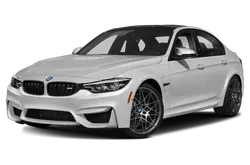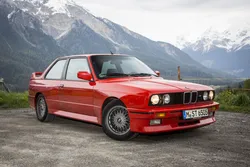

BMW M3 Generation - E30 Model Insights
Explore the BMW M3 generation, focusing on the iconic E30 model. Discover its features, history, and why it remains a classic choice in Portugal.
The BMW M3 has long been regarded as an icon in the world of performance automobiles, and the first generation, known as the E30, laid the foundation for its reputation as a thrilling sports car. Produced from 1982 to ...
Technical Specifications
Select Version
Dimensions
Engine
Driving
Others
History and Features
Mycarro AI
Apr 26, 2025
The BMW M3 has long been regarded as an icon in the world of performance automobiles, and the first generation, known as the E30, laid the foundation for its reputation as a thrilling sports car. Produced from 1982 to 1994, the E30 M3 not only showcased BMW's engineering prowess but also left an indelible mark on the automotive industry, influencing the design and performance of compact sports sedans for years to come.
Origins of the E30 M3
When BMW introduced the M3, it was originally intended as a homologation special to comply with Group A racing regulations. The E30 M3 was based on the standard BMW 3 Series, but it was enhanced with performance-oriented modifications to meet racing specifications. The E30 was characterized by a slightly wider body, a more aggressive stance, and a powerful engine designed to deliver a thrilling driving experience. The model was developed by BMW's M division, which specialized in enhancing the performance and aesthetic appeal of standard BMW vehicles.
Engine and Performance
The E30 M3 was powered by the S14 engine, a 2.3-liter inline-four that was derived from the M10 engine that had seen success in the 1970s. The S14 featured a DOHC design and individual throttle bodies, allowing it to produce around 192 horsepower and 170 lb-ft of torque. This powertrain provided the E30 M3 with an exhilarating 0 to 60 mph time of approximately 6.5 seconds, making it one of the quickest vehicles in its class at the time. The car was also equipped with a close-ratio 5-speed manual transmission, which delivered immediate power and precise gear changes, allowing drivers to fully enjoy the performance capabilities of the vehicle.
Handling Dynamics
One of the standout features of the E30 M3 is its exceptional handling characteristics. BMW engineers placed a strong emphasis on the car's balance, using a rear-wheel-drive layout that contributed to its dynamic performance. The E30 utilized a MacPherson strut front suspension and a semi-trailing arm rear suspension, which provided a perfect blend of comfort and agility. This combination allowed the E30 M3 to carve through corners with precision and stability, making it a joy to drive on both the track and everyday roads.
Design and Aesthetics
The E30 M3's distinct and functional design is emblematic of the 1980s aesthetic, featuring flared wheel arches, a front lip spoiler, and an iconic boxy shape. Available in several colors, including the striking "Raven Blue" and "Mistral Blue," the E30 M3 appealed to a wide range of enthusiasts. Inside, the cabin featured sport seats, a driver-focused dashboard, and ample space for passengers, all crafted with BMW's trademark attention to detail. The blend of performance and comfort allowed for long-distance journeys while still offering the excitement that M3 drivers were seeking.
Motorsport Pedigree
The E30 M3's influence extends beyond the streets and into the world of motorsport, where it achieved considerable acclaim. It dominated racing series across Europe and the United States, particularly during the late 1980s and early 1990s, solidifying its status as a competitive force in touring car racing. With numerous victories in championships like the DTM (Deutsche Tourenwagen Meisterschaft), the E30 M3 became a symbol of BMW's commitment to motorsport excellence, and its success contributed to the M division's legacy.
Legacy and Impact
The legacy of the E30 M3 continues to resonate in automotive culture, with collectors and enthusiasts revering its performance and character. As the first of its kind, the E30 set the standard for all subsequent M3 generations, influencing how performance cars are designed and perceived today. Many would argue that the E30 M3 represents the purest form of BMW's sporting ethos, standing as a testament to the brand's commitment to delivering a thrilling driving experience combined with practicality.
In conclusion, the BMW M3 E30 is more than just a car; it is a symbol of an era in which performance and driving pleasure were at the forefront of automotive design. The first-generation M3 has undoubtedly earned its place in the annals of automotive history, celebrated by enthusiasts and collectors around the world for its iconic status and exhilarating characteristics.
